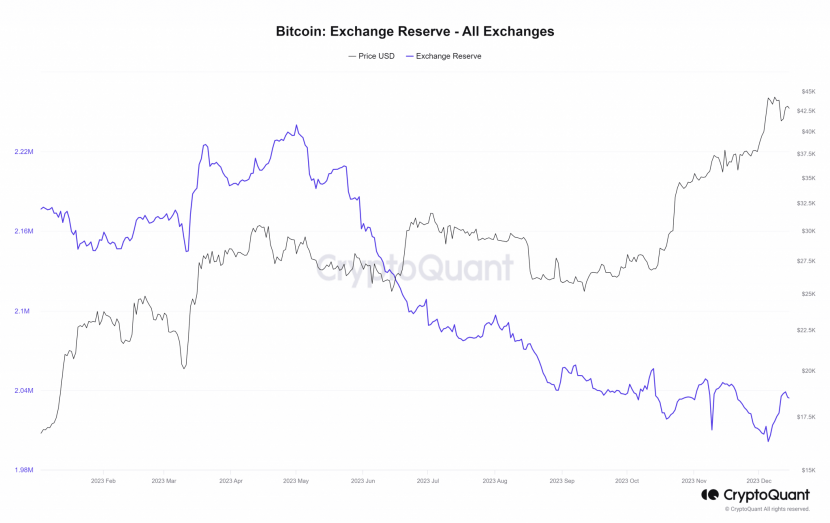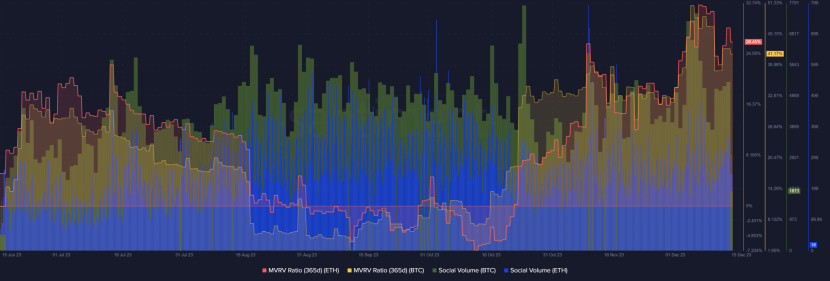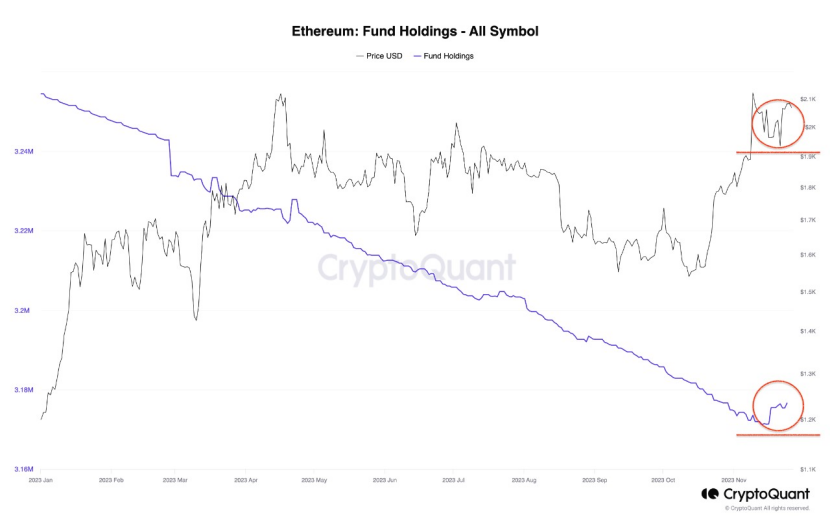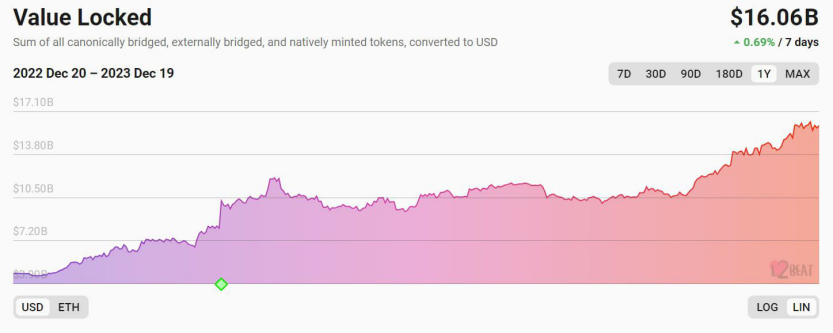ETH/BTC Exchange Rate & On-Chain Data Comparison
Since October, as of December 15th, BTC has risen by 57.5%, while ETH has risen by 48.34%. Although the difference is not significant, the performance of ETH prices has been inferior to that of BTC for almost a year.
The strong performance of BTC mainly stems from the expectation of BTC spot ETF, the approaching halving cycle, and the recent rise of the BTC ecosystem. Although ETH does not have similar positive expectations in the short term, on-chain data still presents relatively positive signals.

Firstly, looking at the most intuitive selling pressure, since June, the balance of BTC on trading platforms has been continuously decreasing, but there was a significant rebound from December 5th to December 12th. After this peak, the price of BTC briefly fell to $41,000.
In comparison to BTC, the balance volatility of ETH on trading platforms is relatively small. Since February 2023, the balance of ETH on trading platforms has been on a downward trend. During the period from December 11th to 13th, the balance of ETH on trading platforms also experienced a slight rebound, but the rebound occurred during and after a period of market price decline. This indicates that some investors chose to transfer ETH to trading platforms for cashing out after a brief market decline.

Additionally, according to data from the Santiment website, in terms of social media attention, the overall trend of the two is similar, but BTC's attention is significantly higher than that of ETH. In terms of MVRV (the ratio of market value to realized value, commonly used to assess buying and selling pressure), the overall trends of the two are similar, but the differences in magnitude are significant. As of December 15th, BTC is at 41.17%, while ETH is at 26.45%, both of which are at their highest points in the past six months.

Although Ethereum's recent price increase is not as strong as Bitcoin's, the trend change in institutional interest in the Ethereum market is still worth noting, a phenomenon that has become more pronounced after November 2023.
According to the chart from the on-chain data website Cryptoquant, institutional holdings of ETH experienced a significant rebound when the Ethereum price stabilized between $1800 and $1900. Cryptoquant believes that the recent sharp increase in institutional holdings of ETH indicates growing interest from institutional investors and recognition of the long-term value and market growth potential of Ethereum. The reasons behind this phenomenon are not only the stability of ETH prices and the potential expectation of ETH spot ETF, but also the solidity of Ethereum's fundamentals and technical upgrades.
In its recent 2024 Financial Outlook report, JP Morgan expressed its position on the cryptocurrency industry. The report indicates that while BTC is approaching the halving cycle, it is expected that ETH's performance next year will surpass that of BTC. JP Morgan believes that the upcoming EIP-4844 upgrade (Proto-dank sharding) is a potential catalyst for its performance, which will enhance Ethereum's network efficiency and scalability, thereby gaining an advantage in the market.
On the other hand, the bullish factors of BTC's halving have already been priced into the current price. The expected BTC block reward halving is expected to increase production costs and may lead to a 20% decrease in its hash rate. According to JP Morgan, this may result in higher operating costs for miners and cause less efficient miners to exit the market.
Key Steps for the Ethereum Dencun Upgrade Initiated
According to the report from the consensus call of core developers, at the end of 2023, Ethereum developers finally initiated the key steps before the Dencun upgrade. Ethereum developers stated that they will launch the Goerli shadow fork with all clients in the next one to two weeks to test the Cancun/Deneb upgrade.
The Cancun/Deneb upgrade testing on Devnet 12 is currently underway. Currently, all execution layer (EL) and consensus layer (CL) client combinations (including the PRYSM client) have been loaded onto Devnet 12. The MEV-BOOST software has been activated for most client combinations (except for the PRYSM client combination).
The Dencun upgrade will bring changes to the two main network layers of Ethereum (execution layer and consensus layer). The upgrade to the execution layer is called the Cancun upgrade, while the upgrade to the consensus layer is called the Deneb upgrade, hence collectively referred to as the Dencun upgrade.
The Dencun upgrade will further scale ETH and L2 by implementing the improvement proposal known as EIP-4844. The Dencun upgrade represents an important milestone in Ethereum's roadmap, and after the upgrade, the transaction fees on L2 will be more competitive.
Returning L2 Functionality to L1 through zkEVM Encapsulation
As L2 networks can bundle transactions for off-chain processing and then bring them back to the main chain, it is a method to improve Ethereum's scalability, which was a key point proposed by Vitalik Buterin at a 2020 conference (at that time, fees on the Ethereum network were soaring).
Recently, Ethereum co-founder Vitalik Buterin believes that as "light clients" become more powerful, returning some of the functionality of L2 to the Ethereum main chain through encapsulating zkEVM will be the next step for Ethereum. Vitalik Buterin proposed returning some of the functionality of L2 networks or rollups to the Ethereum main chain, a method called "zkEVM encapsulation" (zero-knowledge Ethereum Virtual Machine), which is contrary to his viewpoint a few years ago of shifting computational load from the Ethereum main chain to L2 networks.
In a recent blog post, Vitalik Buterin highlighted the importance of light clients, which are client software that operates as a lightweight node. These light clients request data only as needed, rather than independently verifying changes to blockchain data by retaining their own data copies. Typically, light clients or lightweight nodes mainly process block headers and only occasionally download actual block contents.
Vitalik Buterin believes that as their functionality and data increase, these light clients will become more powerful and can even fully verify L1 transactions like L2 networks. At that time, the Ethereum network will effectively have a built-in ZK-EVM.
ZK zero-knowledge proof is an encryption protocol that allows one party to prove the correctness of a transaction to another party without providing any specific transaction details. On the other hand, EVM is Ethereum's virtual machine, which is used to execute programs like a computer, and is responsible for executing smart contracts.
Currently, L2 networks (such as Polygon, zkRollups, Matter Labs) are all using zero-knowledge proofs, and these platforms are major stakeholders in DeFi. Therefore, Vitalik Buterin's method of encapsulating zkEVM may cause these platforms to lose some momentum. So, if zkEVM is encapsulated and becomes part of the Ethereum base protocol, how will the functionality of L2 change?
According to Vitalik Buterin, these L2 projects will still be responsible for many important functions. Some of these functions include fast pre-confirmation, MEV mitigation strategies, and extensions to the EVM. In addition, the method of encapsulating ZKEVM will also handle convenience for users and developers. He believes, "L2 teams have done a lot of work to attract users and projects into their ecosystem and make them feel welcome; by capturing MEV and transaction congestion fees in the network, L2s can gain a certain profit compensation. This relationship will continue."
Key Highlights for ETH in 2024
The Dencun upgrade is expected to be deployed in March or April 2024, and through EIP-4844, the gas costs for Ethereum L2 will be significantly reduced, improving Ethereum's scalability.

Ethereum L2 activity is continuously growing and has now reached historic highs. According to recent data from L2Beat, the total value of the entire ecosystem is $16 billion.
Currently, L2 networks are mainly EVM-compatible, such as Arb, Optimism, Metis, and others. Additionally, non-EVM L2s like Eclipse and Flyent are launching, bringing new types of applications and developers. Cryptogames will mainly be based on the L2 ecosystem, and wallet user experience will continue to improve, allowing the Ethereum ecosystem to attract more new users.
Finally, the tokenization of real-world assets has been gaining momentum, bringing more "old world" financial products onto the Ethereum blockchain.
免责声明:本文章仅代表作者个人观点,不代表本平台的立场和观点。本文章仅供信息分享,不构成对任何人的任何投资建议。用户与作者之间的任何争议,与本平台无关。如网页中刊载的文章或图片涉及侵权,请提供相关的权利证明和身份证明发送邮件到support@aicoin.com,本平台相关工作人员将会进行核查。




